In this comprehensive guide, we embark on a journey to uncover the mysteries behind three types of tiny white worms commonly found in aquariums. From harmless detritus worms to potentially harmful planaria flatworms, understanding these creatures is crucial for maintaining a thriving aquatic ecosystem.

For example, you’ve just discovered some tiny white worms crawling or floating in your freshwater aquarium.
However, you should not be alarmed before taking the time to identify the intruders.
Most of the time, these will be harmless species like the unsightly Detritus worm.
Nevertheless, that’s not always the case and sometimes you’ll need to get rid of the infestation quickly.
So let me help you in identifying and removing the small white worms that have overtaken your new aquarium.
What Types of Tiny White Worms Can Be Found in a Freshwater Aquarium?
When it comes to tiny white worms in aquariums three types of small white worm might prevail in freshwater aquariums such as Detritus worms, Rhabdocoela worms and Planaria.
The First two types are not detrimental if present in small numbers but the last one is highly harmful for organisms in aquariums. These three types of aquarium tiny white worms not only play a crucial role but also exert diverse influence on the aquarium ecosystem.
Detritus worms, which are frequently encountered in filter media and substrates, facilitate nutrient cycling by aiding in the decomposition of organic matter.
Rhabdocoela flatworms are usually harmless and helpful as scavengers of bacteria microorganisms.
Planaria being predators can upset the equilibrium of aquariums by feeding on small invertebrates and fish offspring, potentially affecting biodiversity.
Identification of the species you’re dealing with is important, because while Detritus and Rhabdocoela worms are harmless to fish and shrimp, Planaria may not be.
I would strongly recommend using a magnifying glass when trying to identify the type of tiny white worms you’re dealing with. That’s because the differences between these species are usually very small.
That being said, here’s where the population of worms in your aquarium came from:
A common way of introducing freshwater worms to a fish tank is through new aquatic plants, substrates, or decor.
Overfeeding your fish or shrimp and the lack of regular tank maintenance will provide enough leftover food for the worms to feed on.
Eventually, their population will explode and lead to an infestation.
It’s very likely that some of these worms are always present in an aquarium but there are too few of them to cause any trouble.
Detritus Worms

Detritus worms, also referred as aquarium detritus worms are members of phylum Annelida and include many segmented worms such as leeches and earthworms.
A Detritus worm is not one species of nematode but a collective term for all roundworms that may appear in a freshwater system. Like other Annelida detritus worms, they have segmented bodies that are usually white or transparent in coloration.
These little freshwater white worms are a natural part of the ecosystem and will usually inhabit the deeper parts of your aquarium’s substrate.
There, they help with breaking down excess waste, uneaten fish food and debris.
Usually, white Detritus worms in aquariums will come out of the organic material present in substrate layers when the oxygen levels in the tank are low.
When this occurs, you can find them crawling on the aquarium glass or floating through the water.
These tiny nematodes are only interested in consuming waste and debris.
Detritus worms in fish tanks are more often seen in shrimp tanks because carnivorous fish would usually eat them.
You are not obligated to do anything when you see them, and most aquariums will have them.
To control the detritus worm population, comprehensive control methods and prevention measures can be implemented. These may include frequent substrate vacuuming, ensuring adequate oxygen levels, and preventing overfeeding, all of which can promote their growth.
Author’s note: The substrates of planted aquariums are even more likely to accommodate Detritus worms. That’s because in a planted tank the worms could have been introduced with the many live plants you’ve planted.
It’s also easier for Detritus worms to find food in such systems due to the use of aquarium plant fertilizers. Fertilizers provide more food for bacteria and other microorganisms that Detritus worms feed on.
Identification Guidelines

Detritus worms can be accurately identified visually, aiding in their precise differentiation from other worms commonly found in aquariums.
Detritus worms can be identified by their very thin bodies which resemble a white thread or hair.
They differ in size and usually they are between 0.1 to 0.5 inch up to 1 inch long.
Detritus worms primarily inhabit the deeper layers of the aquarium substrate whereas the flatworms are found adhering on the surface only.
Unlike flatworms, Detritus nematodes will exhibit very active and wiggly movement.
One sure sign that you’re seeing nematodes in your aquarium would be if the little worms float in the water.
Flatworms prefer to glide calmly and do not float.
How to get rid of the many Detritus Worms in your fish tank?
Though harmless to your fish tank and humans in general, Detritus worms can be unpleasant to look at.
If you’re dealing with an outbreak of white nematodes you should try to stay on top of the tank’s maintenance.
Regular cleaning will gradually reduce the detritus worm population to normal levels.
That being said, here are some guidelines on how to get rid of Detritus worms in your aquarium:
- Reduce the amount you feed to your fish or shrimp.
- Vacuum the substrate more often.
- Oxygenate the water with an airstone.
- Use hydrogen peroxide.
- Take care of the plants in aquarium
- Clean aquarium filters .
- Use a detritus worm trap.
- Including natural predators
To implement these approaches several steps are to be followed:
-For moderate feeding simply adjust the quantity of feed provided and instantly remove the uneaten food after feeding.
-To do substrate vacuuming use gravel to remove debris
-To adjust water oxygenation, you can add air stones or reposition the filter output.
Introduction of natural predators like loaches and shrimp that are known to feed detritus worms.
Once the nutrients in the aquarium system are brought back to balance the Detritus worms will visually disappear.
It’s likely, however, that a small number of them will remain on the substrate. Anyway, the frequent use of a gravel vacuum will aerate the substrate enough for Detritus worms to remain underneath it.
Also, attaching a simple air pump such as this one to an airstone helps with keeping the oxygen levels in your fish tank in the norm. The higher oxygen content in the water will not force the Detritus worms to stick their heads out of the substrate.
On the other hand, some events that abruptly lower the oxygen in your tank and make Detritus worms pop out could be:
- Blooming heterotrophic bacteria during aquarium cycling. In these cases the water in the tank starts looking foggy;
- A broken HOB filter that has stopped working for some time. The water movement that HOB filters create oxygenates your aquarium;
- Increase in the water’s temperature. Warm water holds less oxygen than colder water;
- A bloom of phytoplankton (green water). Phytoplankton is microscopic free-floating algae that, during nighttime, use a lot of oxygen;
- You’ve accidentally overdosed with a water conditioner such as Seachem Prime. In large doses Prime can deplete the water in your tank of oxygen;
- Overcrowding the tank. Fish themselves use up oxygen and having too many in one tank is never a good idea.
Anyhow, a sudden swing in the water’s parameters could also bring these nematodes out. For example, it’s not unseen for them to start floating around after a large water change.
Author’s note: Guppies and Endler’s Livebearers absolutely love eating tiny roundworms. A small group of Guppies will eradicate a large population of Detritus worms in a matter of days.
Rhabdocoela Flatworms
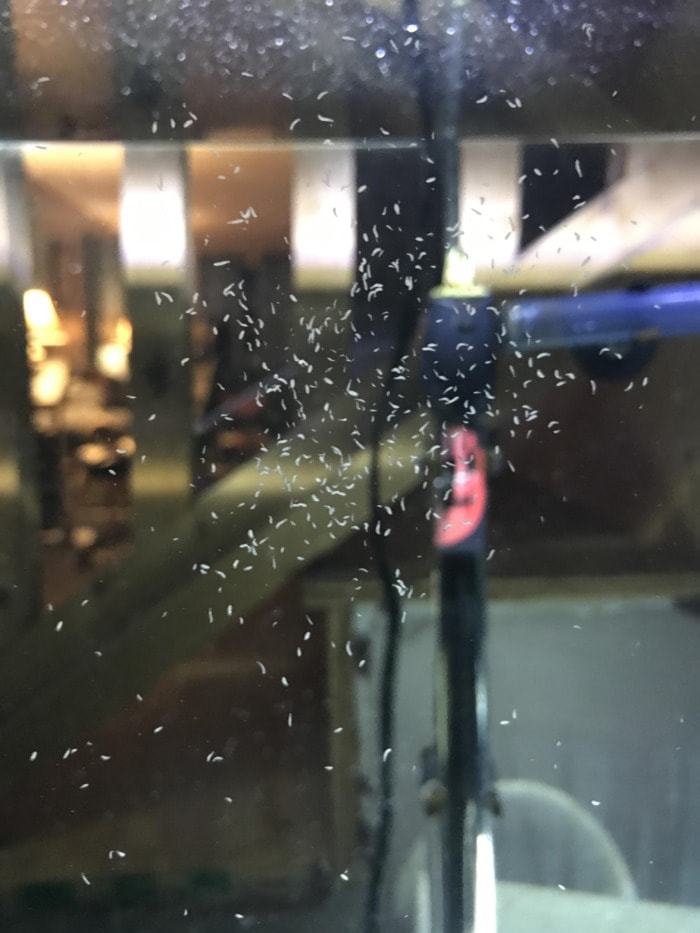
The Rhabdocoela worm also known as the disc worm belong to the class of Turbellaria within the phylum platyhelminths. The Rhabdocoela are distinguished by their slim, elongated, and microscopic size.
These worms in aquariums typically reside in various habitats such as the substrate, filter media, and water column.
These worms on fish tank glass or in the water column are a type of freshwater flatworm that feeds on bacteria and microalgae.
These harmless flatworms will not prey on your fish or shrimp and are part of the natural ecosystem in the tank. You may also find the Rhabdocoela worms swarming on plants or fish that are already dead.
Controlling the population of Rhabdocoela in an aquarium is quite challenging. Specific control measures are limited, however ensuring optimal water quality by performing routine filtration and filtration management can help reduce population.
Preventive measures focus on minimizing the accumulation of organic debris and avoiding overfeeding.
Anyway, Rhabdocoela is one of the most common types of white flatworm seen in the aquarium.
How to Identify Them?

The Rhabdocoela flatworms are characterized by a very tiny size as they will rarely grow over 2-5mm in length.
Another key component to their identification is that they will slowly glide on the aquarium’s glass and will not appear to wiggle like Detritus worms in fish tanks. Rhabdocoela worms have more erratic movement, often wriggling.
Rhabdocoela has thinner, slim, and elongated body whereas planaria have much broader and distinct shape. Rhabdocole has two round ends and does not possess the typical triangle-like head of the larger Planaria.
Removing Rhabdocoela Worms
Same as with Detritus worms, Rhabdocoela populations are a result of too many nutrients in your aquarium system. Removing the Rhabdocoela worm in aquariums can be achieved through several effective methods:
To get a Rhabdocoela population under control I recommend vacuuming the gravel of your tank more frequently.
Also, reducing the amount of food you offer to the system may help too. Only provide food that can be consumed within a few minutes.
Introduction of predatory dishes such as loaches or gouramis that feed on small invertebrates.Furthermore, most small fish with a predatory instinct will likely make short work of Rhabdocoela. For example, Betta fish feed on small crustaceans and worms in the wild, and so will love eating Rhabdocoela flatworms.
Planaria Flatworms
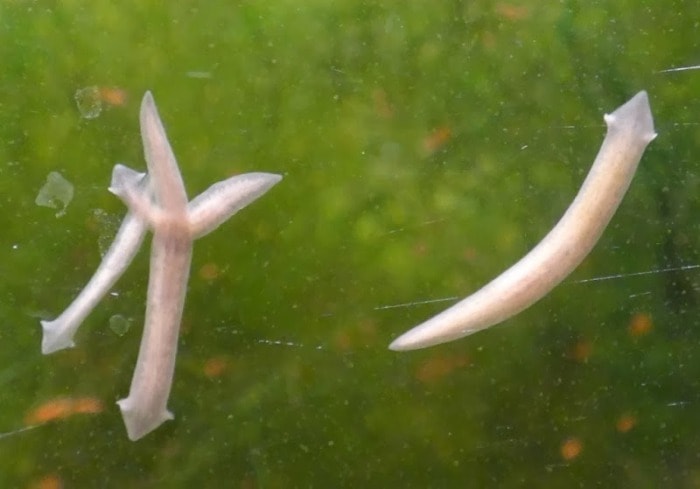
Planaria flatworms are commonly referred to as red planaria flatworm. Planaria belongs to the class Turbellaria within the phylum Platyhelminthes. They are easily identified by their unique flattened bodies, ciliated epithelium and red-brown coloration. Planaria are a species of carnivorous flatworm that is predatory in nature. These are the worms you don’t want in your aquarium for too long.
Planarian flatworms can mainly be a threat to various types of small freshwater snails and a shrimp population. These worms would feed on shrimp eggs and baby shrimp at night. Their ability for regeneration makes them resilient and difficult to manage once they have settled in an aquarium.
Adult shrimp that are molting can also be at risk of a Planaria attack. Anyway, some aquarists claim that they’ve witnessed Planaria worms paralyzing live adult shrimp.
Prevention measures are essential for preventing the entry and spread of Planaria flatworms in aquariums. These include thoroughly inspecting new plants, substrate, and tank decorations for hitchhiking worms before adding them to the aquarium. Quarantining new additions and keeping proper tank cleanliness.
This would imply that the flatworm uses a toxin of some sort.
I did some research on the subject and here’s what I found:
Freshwater Planaria are not known to have any toxins in their body but they are not a well-researched species. I’ve also found a peer-reviewed study concluding that some land-based Planarian worms produce a neurotoxin called Tetrodotoxin.
However, the land-based Planarians seem more sophisticated than the ones we get in our aquariums.
Anyhow, Tetrodotoxin is the same neurotoxin that some marine pufferfish produce and there’s no antidote.
Another study I found during my research suggests that these pufferfish actually get the toxin from eating a type of marine flatworm. This marine flatworm was not related to Planaria, however.
Anyway, there’s also this video that shows what seems to be a dying shrimp with a Planaria worm on it:
I think that it’s unclear whether or not the shrimp was already dying or is being killed, and the description of the video is quite speculative.
Key Traits to Identify
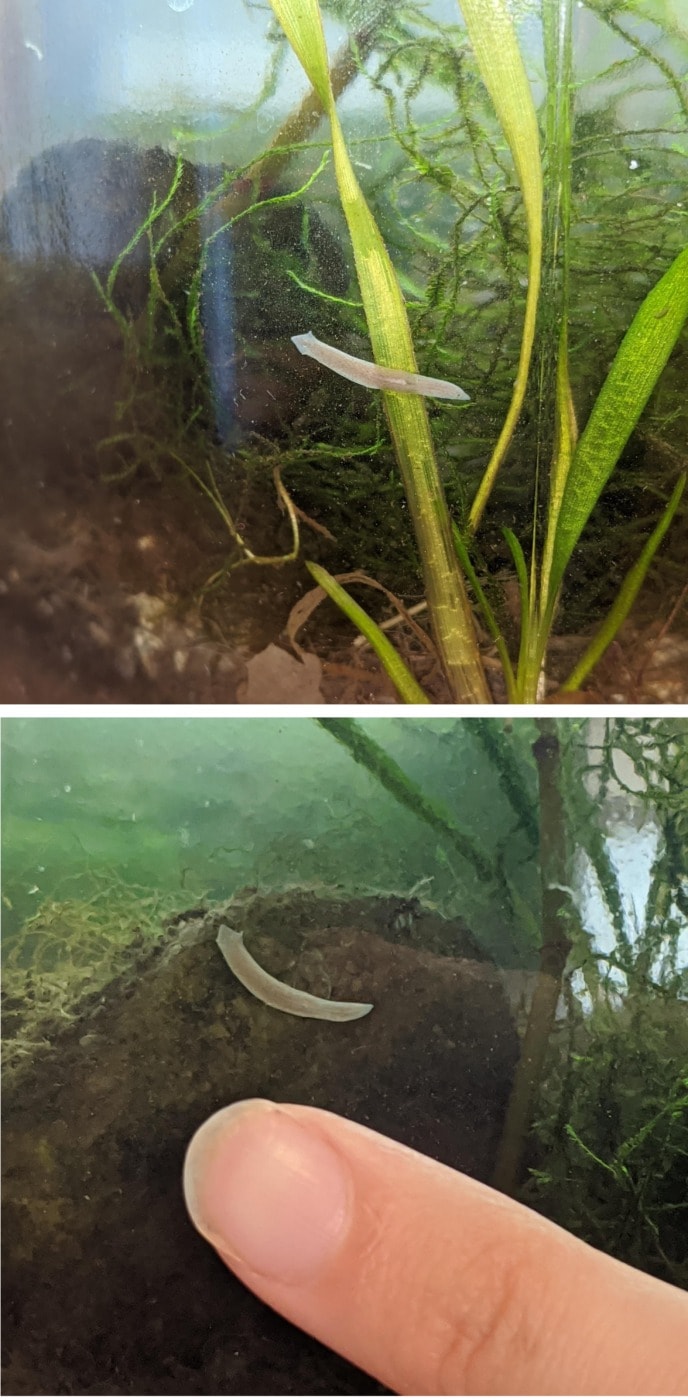
Young Planaria look like small white flatworms that have a distinctive triangular head with two eyespots on it.
Adult Planarians can grow up to 1.5 inches (4 cm) but will usually remain around 1 inch in body length (2.54 cm). They vary in size from 3-15mm (0.1- 0.6 inches) length.
Adult Planaria worms can develop a pink tint to their body.
Planaria vs detritus:
Unlike detritus worms, planaria flatworms have a flattened body featuring distinct bilateral symmetry, giving them a ribbon-like appearance. Their bodies are typically more elongated and slenderer compared to the rounder, segmented bodies of detritus worms.
In terms of habitats and behaviors, planaria flatworms are commonly found in several aquatic environments, including freshwater fish tanks, ponds, streams, and occasionally in moist terrestrial environments.
Within fish tanks, they frequently dwell in substrate layers, hiding in crevices, under decorations, or among aquatic plants. Planaria flatworms are nocturnally active, with peak activity occurring during dim-lighting conditions.
If you’re dealing with an infestation of planaria flatworms in your aquarium, there are various methods to get rid of planaria .Another key trait of Planaria is that they move slowly and prefer to creep on surfaces.
They do not float or wiggle like round Detritus worms.
Author’s note: Often Rhabdocoela will get misidentified as Planaria. The difference between the two worm species is that Planaria in aquarium grow considerably larger and have spade-like heads. Rhabdocoela, on the other hand, stays relatively small and has two rounded body ends.
More often than not aquarists would encounter Rhabdocoela in their tanks, rather than Planaria.
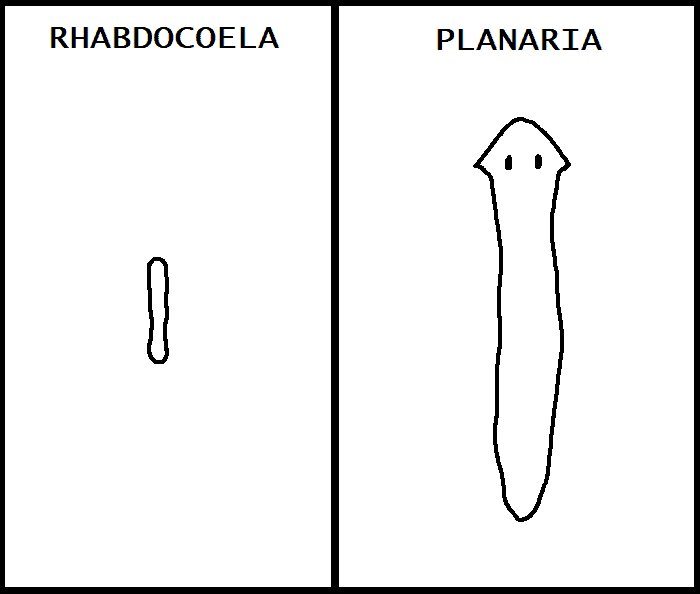
How to Rid Your Tank of Planaria Flatworms?
Planaria flatworms are not usually an issue in tanks that house enough predatory fish.
As long as the worm fits in the mouth of a fish – it will get eaten.
However, you can’t always add predatory fish to a tank.
The main issue arises when you have a shrimp tank where adding predatory fish for the sake of eradicating the planaria doesn’t make sense.
In that case, the fish will hunt down and decimate the shrimp population even faster than Planaria.
Also, it can be very difficult to catch small fish if by any chance they do their job and it’s time to remove them.
So if you’re a shrimp keeper with a nasty Planaria problem there are only 2 options left for you.
Take a look at the two methods that you can try to rid your planaria in aquarium:
- Kill it with a chemical treatment;
- Naturally, export the worms from the tank with a Worm Trap.
First, let me teach you the natural method as it’s always better to go that way when dealing with live animals.
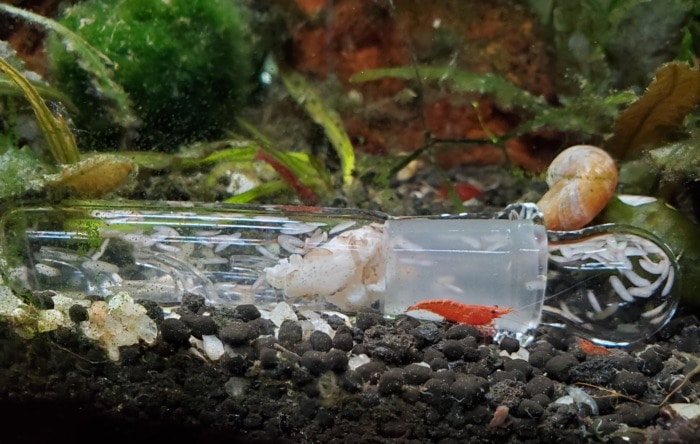
1. Make a DIY Planaria Trap.
A worm trap, in the context of fishkeeping, is a container with holes that lures the worms in:
- You put inside some food as bait and wait.
- The worms enter the container to feed.
- After that, you export the flatworms from your aquarium and repeat the process until you get rid of planaria totally.
There are different ready-made worm traps that you could get online and this is one such example that has received a lot of positive feedback.
However, I would recommend doing your own version of it for two main reasons.
Obviously, one reason is that you will save time and money.
The other, more important, one is that commercial worm traps are too small to rid your tank of a flatworm infestation quickly.
By making your own DIY worm trap you can export much more Planaria at once.
That being said, here’s how to make a Planaria trap yourself:
- Get a 16.9 oz plastic bottle of some sort.
- Rinse the bottle inside-out.
- Perforate 4 holes on the bottom of the bottle by using a needle or a pin.
- Invert the top half of the container and place it back onto the bottom half, creating a funnel-shaped trap.
- Secure the two halves together with tape or rubber bands.
- Put a very small number of fish flakes inside the bottle.
- Place the trap in your aquarium overnight.
- In the morning, remove the trap and dispose of any planaria trapped inside.
After following these simple steps you’ll have yourself a DIY worm trap ready to be put in action!

Anyway, before I continue I need to explain some of the steps further.
Though the needle holes may seem too small, you should know that Planaria are very good at squeezing their bodies in tight spaces.
Make the holes any larger than that and you risk making the trap inefficient.
Another thing I would like to point out is that you should not put too much fish food inside the trap.
Otherwise, you risk Ammonia and Nitrite levels rising which can be even more devastating to your shrimp colony than Planaria flatworms. You could use any fish food that supposedly has meat in it, and you can use actual raw meat but in very small amounts.
The better the bait the more worms you’ll catch at once.
Anyhow, after your worm trap is done, you just put it inside your tank and wait.
Hold the bottle down while it fills with aquarium water and starts to sink.
Push the bottom of the bottle in the tank’s substrate with a gentle twisting motion.
Let it sit there in a straight position with the bottom slightly buried.
For the best results, set the worm trap right before lights out and take it out the next morning. Planaria are nocturnal predators and become most active during the night.
Anyway, the next day you may feel somewhat grossed out by the huge number of flatworms inside the bottle, but this means it’s working.
Get the bottle out and rinse it in your backyard or somewhere outdoors.
Author’s note: Never let Planaria go down the drain. You don’t want what happened in your aquarium to happen in your drinking water facility. I usually dispose of the worms over soil where they will dry out and get eaten by other critters.
Anyhow, repeat this process until there are no Planaria in the bottle the next morning.
A heavy worm infestation takes 3 to 4 days to get rid of.
2. Use a Dewormer.
Chemical Treatment Protocol:
- Commercial treatments specifically designed to target planaria flatworms are available in pet stores. These treatments typically contain chemicals such as fenbendazole, which are effective at killing planaria.
Some aquarists swear by a canine dewormer known as Panacur C, which does work.
However, I prefer a more natural remedy known as No-Planaria. I’ve chosen the exact product in the link.
Its active ingredient is an extract from Betel Nut, a type of palm tree. Anyway, don’t forget to remove your carbon filter media before the treatment and follow the instructions on the label of No-Planaria closely.
Carbon can absorb the active ingredient in No-Planaria and make it inefficient. The powder itself may cloud the water in your tank at first, but this will go away quickly.
Also, make sure to convert the gallon capacity of your tank in liters because that’s what No-Planaria use in their guidelines. While doing the unit conversion try to estimate what volume of water the decor in the tank displaces and subtract that from the overall gallon capacity.
Anyhow, using No-Planaria does work and, as a remedy for flatworms, is safe for shrimp.
Unfortunately, some of your more sensitive freshwater snails may perish during the treatment.
However, what I would consider the biggest disadvantage of this Planaria removal method is the need to lower potential ammonia spikes after the worms die out. All of the Planaria worms will be dead in roughly 72 hours, but most of them can remain in your substrate.
There, they will start to decompose which can throw your tank’s parameters off the chart.
For this reason, I’d advise doing a thorough substrate vacuuming after the treatment is over.
By vacuuming the substrate you’ll rid your aquarium of the small leftover worms that have plagued it.
3. Natural Removal Methods:
- Introducing natural predators of planaria flatworms, such as certain species of fish or invertebrates, can help manage their population. For instance, certain types of loaches, gouramis, or even some freshwater shrimps are recognized to feed on planaria.
- Step-by-step instructions:
- Research suitable predatory species for your tank size and compatibility with existing tank inhabitants.
- Introduce the predators into your aquarium gradually to minimize stress and aggression.
How to prevent future aquarium worm outbreaks

Even though there are worse pests than aquarium worms, dealing with a worm outbreak can still be a nuisance.
Sure, you can use a trap to get rid of the worms, but this can still take you more than three days.
And if you’re queasy, you probably won’t want to do it more than once.
Fortunately, you can take some simple precautionary hygiene practices so aquarium worms never rear their ugly heads again.
Here’s how to prevent future aquarium worm infestations:
- Rinse plants before putting them in your aquarium. Aquarium worms most often end up in our tanks through plants.
- Being masters of disguise, these tiny critters hide in the plant’s leaves or lay their eggs there.
- And once they enter the aquarium, they bury themselves in the substrate in search for nutrients.
- This holds especially true for planaria worms which are often introduced to the aquarium through pond plants.
- So if you want to spare yourself some headaches, I recommend you don’t source your plants from unreputable stores or unclean local ponds.
- Anyway, if you carefully inspect every new plant and rinse it with water, you should be able to wash away any slugs or eggs that may be present.
- Don’t feed your fish more than they can eat. Even if you thoroughly wash every plant and piece of decor you add to your aquarium, a few worms or eggs might still end up in your tank.
- This, however, won’t lead to a full blown infestation if your fish are fed with moderate amounts of food.
- Aquarium fish shouldn’t be fed with more food than they can eat in three minutes.
- So if yours are having trouble keeping up, you should cut back on the food, because worms will gladly feast on the leftovers.
- Additionally, it’s good to keep in mind that carnivorous fish should be fed roughly once a day, while omnivores will require two feedings.
- Don’t skip on maintenance. It’s completely natural if you forget to trim your plants or vacuum your substrate once in a while.
- But if you regularly skip your maintenance routines, you’re begging for a worm outbreak.
- After all, nematodes are known as Detritus worms for a reason.
- So if you don’t want to deal with these pesky critters ever again, remember to siphon the aquarium substrate on a weekly basis and remove any dead leaves you find.
Conclusion:
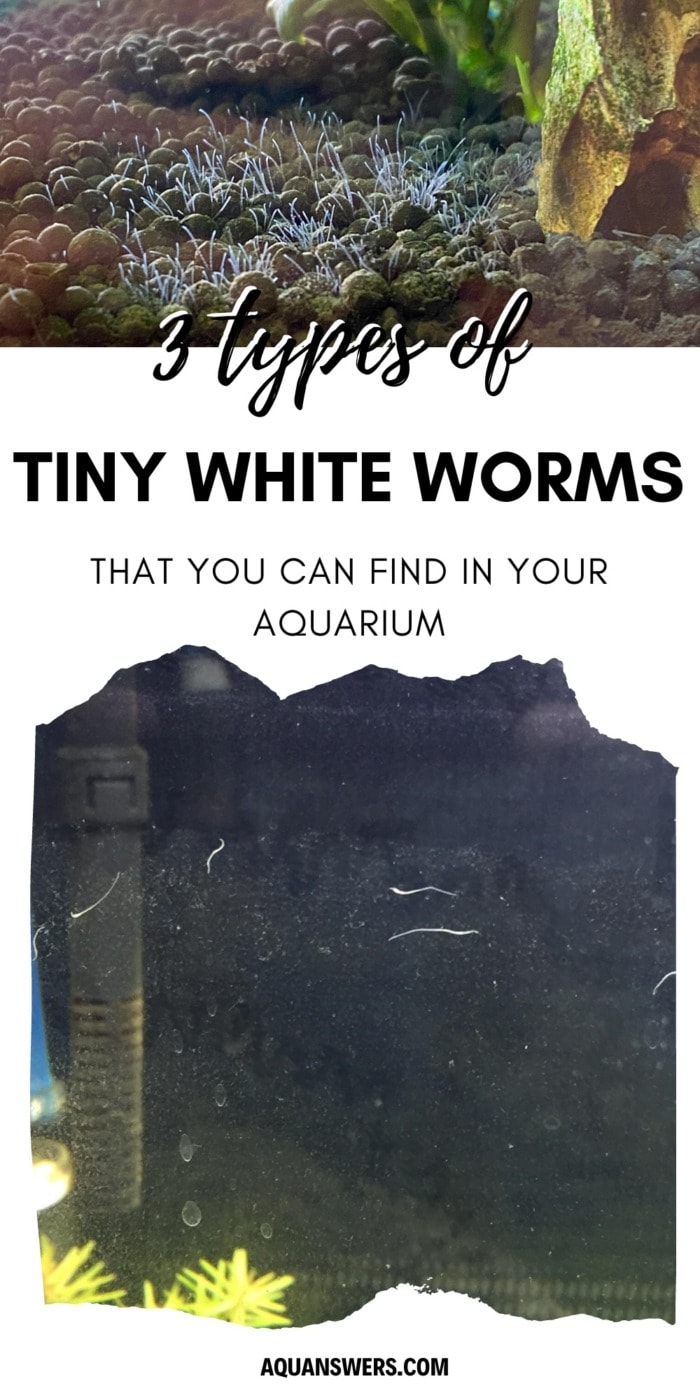
Dealing with tiny white worms in aquarium can be alarming, but with accurate identification and effective removal techniques, it is manageable. Comprehending the traits and behaviors of Detritus worms, Rhabdocoela flatworms, and Planaria flatworms is essential for determining the appropriate course of action.
Implementing preventive measures, such as inspecting new plants and moderating feeding, can help mitigate future outbreaks of aquarium worms. Adhering to these guidelines and maintaining regular tank maintenance, aquarists can guarantee a healthy and balanced aquatic environment for their fish and other inhabitants.







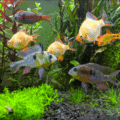

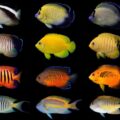
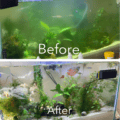
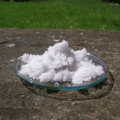



Valuable information, thank you!
could planaria be long and pink?
Yes, they can be pink. Does the head look triangular to you?
Thank you SO much for this article, I only started keeping fish a year or so ago, so when I found a few little detritus worms wiggling around after a water change, I was incredibly worried and a little bit panicked, as you can probably imagine. Anyway, thank you so very much.
Great explanation and well chosen pictures.
I’ve seen 3 white worms (which I now know are detritus worms) floating around my tank.
Thanks for also explaining why they come out of the substrate. I recently added a second Tropica system 60 because my tank is more than twice the size for which these are meant, so I have a feeling that this is the reason they came looking for more oxygen.
Hi there I’ve been having a problem with white spots(ick) on my fish so I was told to do coarse salt treatment to my freshwater tank,I did this and a week went by all good with my tank no white spots but now I found 5 dead guppies in two days .any advice on what I can do.i have removed the fish put them into a clean tank ph levels are good and temps are between 38 and 39 dagrees I don’t have plants or gravel at the moment in the tank.
Hello,
38 and 39 degrees? If that’s Fahrenheit it is way too low, if it’s Clecius it is way too high. Is it possible you made a mistake? If not – there’s your problem.
Try to adjust the water’s temperature with multiple small water changes…
Ya ur tank should be between 76° – 80° F.